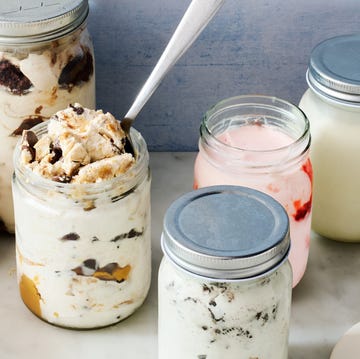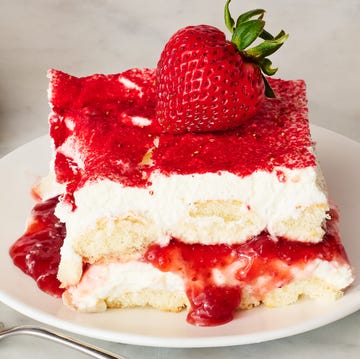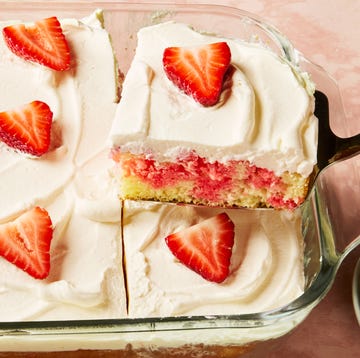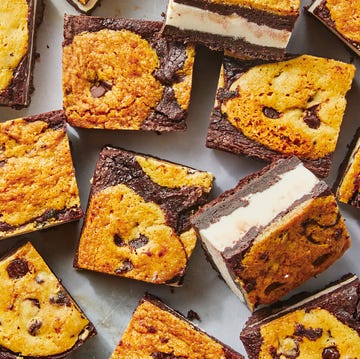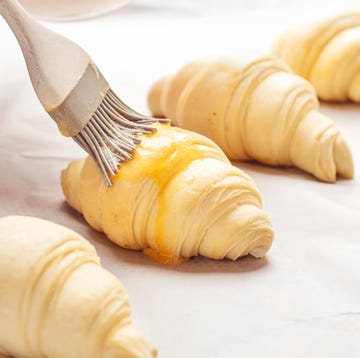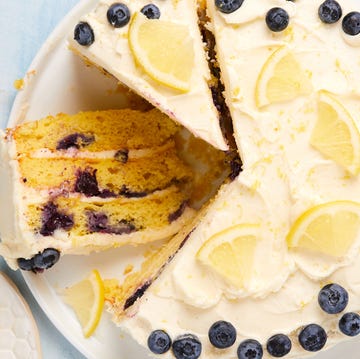The word "vintage" might conjure images of thrifted band tees or your mom's denim jacket, but in the cake world, it means towering layers, intricate piping, and swirls of buttercream. And vintage-style cakes are making a comeback. These lavish confections have taken over social media feeds, where home bakers-turned-entrepreneurs showcase their creations.
Minimalist, sleek fondant cakes that defined the 2010s are out. Now, the chicest cakes celebrate frosting layered and sculpted into intricate designs and decorative appliques. The notion of "too much" doesn’t seem to exist.
But how did we get here? Much like the sugar rush you'd get from a spoonful of buttercream, the vintage cake boom emerged slowly at first, then exploded all at once.
What’s A Vintage Cake?
This Antoinette-esque decorating style is largely attributed to Joseph Lambeth, the author of Lambeth Method of Cake Decorating and Practical Pastries, which was published in 1934 and again in 1980.
"The style is defined by its layered piped decorations, especially overpiping with delicate string work or buttercream piped over itself using various pastry tips to create intricately layered designs," says Kierin Baldwin, Chef-Instructor of Pastry & Baking Arts at the Institute of Culinary Education in New York City.
Vintage cakes today typically use buttercream, although early versions were decorated with royal icing, which Baldwin says has a long history in English cake decorating. Unlike buttercream, royal icing doesn’t contain any butter or fat—it’s traditionally just sugar and egg whites. It’s often used to decorate cookies, as it hardens with a glossy sheen.
"While many associate this particular style with the Victorian Era because of its ornate detail, and it was developed by pastry chefs during that time period, Lambeth deserves much credit for popularizing it in the early twentieth-century interwar period," Baldwin notes.
The style is also associated with the '70s and '80s, when over-the-top piping was just as prevalent as hairspray and shoulder pads. Wedding cakes mirrored the gowns of the era—voluminous and full of detail. (Think: Princess Diana's iconic wedding dress).
"Everything was vintage cakes," Lisa Mansour, Director of NY Cake Academy and one of the founders of the NY Cake franchise, says of growing up in the 1970s. "I started on vintage cakes, so it’s really cool for me to see it come around again." Founded in their kitchen by her mother, Joan Mansour, the family business has been around since 1991, seeing cake trends come, go, and return.
After its boom in the 1930s and again toward the end of the century, the Lambeth cake was eventually overshadowed by fondant. Shows like Ace of Cakes, which premiered in 2006, and Cake Boss in 2009, ushered in the era of fondant-covered cakes that often tried to resemble anything but cake. Then there was the naked or austere cake, popularized by Christina Tosi of Milk Bar. (Tosi’s iconic Birthday Cake skips frosting on the sides so you can see the cake layers.)
And now, in the same way that fashion trends cycle back to bygone styles, cakes have returned to the opulence of layered buttercream—but with a modern twist.
‘Going Back To Buttercream’
Cake decorating styles come and go, but that's just one of the reasons Monsour says vintage cakes are back in style. Along with the popularity of vintage clothing, she believes shows like "Bridgerton" have influenced the trend. Set in early 19th-century England, the fictional series draws on styles from the Regency era with lavish interiors and flowing dresses with puff sleeves and intricate detailing.
And then there’s the post-COVID shift. When people were making sourdough and experimenting in the kitchen during the pandemic lockdowns, it was because they had the time. And vintage cakes require that. "It’s a time-consuming art, and I think people are just fascinated with it and want to learn it and try things at home," Mansour says. "It’s going back to buttercream, basically."
For 40 years, NY Cake Academy has offered a variety of classes, namely its popular Cake Decorating 101, which teaches foundational skills and basic Lambeth piping techniques, like shells, stars, ruffles, and rosettes. But in recent years, as the popularity of vintage-style cakes has grown, they’ve also offered Vintage Lambeth Cake Decorating, which builds on these techniques.
"We layer them," she says about the skills. "That’s what vintage cake is about. It’s about over-piping and layering and layering, and that’s what makes it so intricate."
The Vintage Cake Boom
Since 2020, the term "vintage cakes" has been trending upwards in search interest, according to Google Trends data.
This was around the time Lulu Naideau’s vintage cake business, Bodega Cakes, took off. It was also the year Ali Gala started her business, Disco Sugar. While both women always loved baking, neither is a trained cake decorator. But somewhat serendipitously, their hobbies turned into businesses through social media.
Naideau made 12 mini cakes inspired by zodiac signs for a Super Bowl party and posted photos to her Instagram. After receiving a great response, she started the Bodega Cakes (@bodegacakes) account. The soon-to-be therapist then sold a lot of cakes at a fundraiser for The Door, a local youth organization where she used to work. By the end of the year, she was making cakes for weddings and events.
Gala, who had only taken a cake decorating class in the third grade, was working at a restaurant that didn’t have a pastry chef. While decorating cakes for work, she became "absolutely obsessed with vintage cakes," creating @disco.sugar to showcase all her projects. She learned everything from YouTube and Instagram, making cakes for family and friends. Then, after receiving direct messages, she started whipping them up for strangers.
Bodega Cakes and Disco Sugar are just two of the many vintage cake businesses that have exploded on social media, but each has a distinct look and feel.
"Joy-inspired is gross, so I don’t want to say that," Naideau says when I ask about her cake decorating style. Instead, she lists her influences: old ads that evoke emotion and familiar things turned all the way up.
"I think my unique spin on it takes everything to a little bit of the next level," she says. "It also inevitably feels like perfectly imperfect."
Unlike contestants on cake decorating shows popular in the 2010s, Naideau and Gala don't sketch their cakes before baking. "For most of my cakes...I'm pretty much going off of vibes," Gala, who describes her decorating style as retro, colorful, bold, and fun, says. "Vintage cakes look and feel like a party to me."
But that doesn’t mean they’re easy to make. From brainstorming and shopping to baking and decorating, a cake can take multiple days from start to finish. Naideau says that the decorating portion is actually one of the smallest parts of the process, compared to conceptualizing a custom cake.
They’re not cheap, nor should they be, given the care and time that goes into making each one. Depending on size and scope, a custom cake could cost several hundred dollars. A store-bought cake‚ or even a Milk Bar cake, will set you back much less.
But in an era of conscious consumerism, when some people are placing more emphasis on how a purchase aligns with their values and ethics over cost, the price of a custom cake might not be an inhibiting factor. "I think personalization is becoming really important to people," Naideau adds, noting a broader cultural shift toward individuality and away from mass production.
Unlike the colloquialism, "just buy the bag," Naideau says the mentality of "just get the cake" isn't necessarily about treating yourself. "It's about giving yourself permission to have the thing that turns a moment into a celebration."
The Moment For Vintage Cakes To Flourish
Why are vintage-style cakes so appealing right now?
First, there's the tactile quality. "It’s incredibly satisfying to see something in front of you with such an extreme level of texture and detail, especially when we spend so much time interacting with our phones and computers," Naideau says.
"People are craving craftsmanship and extravagance; something unique and memorable for their parties," Gala says. "And vintage cakes definitely have that—they’re literally art. It’s not something that can be replicated, at least not very easily."
And vintage cakes aren’t just for weddings or birthday parties. Naideau has piped "just divorced" and "legally single" onto cakes marking relationship splits. "When people are having celebrations that aren't like birthdays, I'm still including candles."
"I think that getting together with the people that you love, sharing cake, and celebrating is a really radical act," she says. "Even when it feels hard, celebration is so important—and cake can allow it to happen."
Vintage cakes may be the trendy confection of 2025, but there is something truly timeless about them. After all, they've made their way back into the spotlight time and again over the past century. Plus, our appetite for buttercream-covered nostalgia isn’t waning anytime soon. Who could possibly say no to a little extra frosting?







